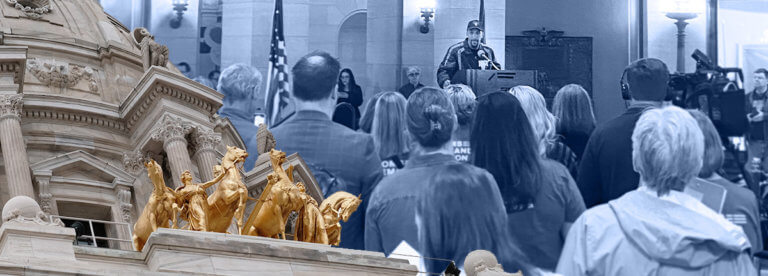No time to sift through Governor Dayton’s budget proposal? No problem. Here, I’ll break down some of the important pieces of the budget proposal – and provide a reminder about where we could’ve been if we had followed the House GOP tax plan from 2015 (spoiler alert: it looks like a $2 billion budget deficit and decimated fiscal stability).
Pioneer Press: Mark Dayton proposes $117 million in tax cuts, $581 million in new spending
“In releasing his budget requests for this year, DFL Gov. Mark Dayton on Tuesday repeatedly used watchwords that more commonly spring from Republican lawmakers: ‘fiscal integrity.'”
North Star Policy: Governor’s Budget Focused on Fiscal Stability
“On the tax front, the Governor is targeting tax relief to low and moderate-income households through an expansion of the Minnesota Working Family Credit (WFC) and the Child and Dependent Care Credit. The WFC is patterned after the federal Earned Income Tax Credit and is equal to a percentage of earnings, up to a maximum amount; the amount of the credit is phased-out as earnings increase. The WFC is credited with providing needed tax relief for low-income families while still encouraging work..
“Mindful of the possibility of deteriorating economic conditions and the fact that inflationary pressures could take a big bite out of the $1.2 billion surplus projected for the upcoming FY 2018-19 biennium, the Governor proposes leaving a significant amount of the surplus on the bottom line. His supplemental budget leaves unspent $202 million in FY 2016-17 and $369 million in FY 2018-19.”
The Star Tribune: Dayton outlines $100M proposal to reverse racial disparities
“Gov. Mark Dayton issued a $100 million edict to legislators last week, laying out a legislative agenda aimed at ensuring racial equity. His proposals, if enacted, would provide one-time infusions of capital into business-development programs, youth employment initiatives and down-payment assistance for lower-income first-time home buyers. He also wants more funding for the Department of Human Rights, a state agency that investigates complaints of discrimination in workplaces…In the months leading up to the unveiling of Dayton’s racial equity agenda, the governor’s office sought input on proposals from community groups such as the Minneapolis NAACP, Northside Funders Group and Neighborhoods Organizing for Change, a north Minneapolis nonprofit. Dayton said it’s important for minority groups to have input on proposals.”
Post-Bulletin: Our View: New spending plan offers flexibility
“Saving $200 million this year in case 2017 offers a repeat performance makes sense. We know there are those who would like to see the state return the remaining funds to taxpayers, either through tax relief or added programs, but failing to plan ahead could leave lawmakers in a position requiring them to undo the accomplishments seen in recent years.
“Taking the prudent step toward ensuring future flexibility will help the state remain on the right track.”
Minnesota Budget Project: Governor Dayton’s 2016 tax proposal focuses on everyday Minnesotans through working Family Credit, Child & Dependent Care Credit
“In the tax portion of his supplemental budget proposal released today, Governor Mark Dayton continues to prioritize sustainable tax choices that move Minnesota toward a tax system that is more equitable across income levels. It is especially focused on supporting the work efforts of middle-class Minnesotans and those working their way into the middle class through expansions of the Working Family Credit and the Child and Dependent Care Tax Credit…His supplemental budget reflects an appropriate sense of caution. It doesn’t go too far on tax cutting: it makes $117 million in net tax reductions in FY 2016-17 and $154 million in FY 2018-19, and provides a one-time $47 million boost in FY 2017 in local aids to cities and counties. Because the tax cuts are reasonable in size, that allows the governor to make additional investments in broader economic opportunity elsewhere in the budget. It is a time for budgetary caution, but there is also urgency to expand the state’s economic prosperity to those it hasn’t yet reached. Dayton’s tax proposal finds the right balance between these two priorities.”
Piqued your interest? Here’s a link to the governor’s line-by-line breakdown of the budget proposal priorities.
And finally, all of this begs the question: where would we be if Governor Dayton and the DFL hadn’t worked together to build a healthy economy in Minnesota? Wonder no more, since the North Star Policy Institute has run the numbers.
North Star Policy: 2015 Tax Proposals: a “What If” Analysis
“The House tax bill would have reduced state general fund revenue by $2,274 million based on the tracking sheet, which would have exhausted the $900 million surplus and created a $1,374 million deficit, assuming no other changes to current law. Of course, other changes would have been made. The tax relief bestowed by the House tax bill would have created the need for some combination of spending cuts, utilization of reserves, and/or accounting shifts (such as the K-12 school funding shift) totaling nearly $1.4 billion in order to balance the state budget in the current biennium.”
Thanks to Governor Dayton and DFL legislators for putting us on a path to building an economy that works for all of us – not just the wealthy few.



